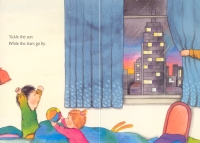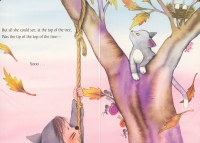| ________________
CM . . .
. Volume XIV . . . . August 31, 2007
Each of the books in the “Alligator Tales” series of board books focuses on a single Dennis Lee poem that originally appeared in one of his collections. The poem “Skyscraper” was part of Lee’s Alligator Pie (1974) whereas the action rhyme “The Kitty Ran Up the Tree” was found within the “Finger and Toes” section of Jelly Belly (1983).
The transformation of a poem from something that was initially just a small part of a larger work into a separate work that now stands on its own has both advantages and disadvantages. Once simply an eight-line poem found on a single page accompanied by an illustration, the lines of “Skyscraper” now flow over five pairs of facing pages in Skyscraper. Although the skyscraper remains the poem’s focus, Hilb’s illustrations have created a wordless plot involving a boy and his younger sister. The perspective is static in that the city’s skyline, with the dominant skyscraper, can always be seen through the boy’s bedroom window, but the changing sky plus the sun’s position indicate the passing of time, a period beginning and concluding with nighttime. Little details in the illustrations offer clues as to what the children have been doing when they are not actually present in the illustrations. Again, illustrator Hilb adds an additional “unwritten” storyline to Lee’s poem. “The Kitty Ran Up the Tree,” in the now board book of the same name. Accompanying the cat in a journey up and down the tree is a young child, dressed in a cat suit, who is climbing up a knotted rope attached to one of the tree’s branches. Waiting below, is the child’s dog. As was the case with Skyscraper, Hilb adds additional small details, such as a pair of climbing snails, that can be considered and discussed during subsequent “readings.”
Turning poems into separate books potentially causes two qualities of poetry to be lost. The number of illustrations can possibly overwhelm the words’ impact while suggesting that there is but one way to interpret the poem. As well, instead of being able to see the poem in its entirety on a single page, the reader finds the lines divided over a number of pages, and the need to physically turn the pages could cause the poem’s natural rhythm to be interrupted. However, I believe the prospect of these negative possibilities actually occurring is more than offset by the early introduction of Lee’s poetry into a child’s life. And when the child later meets the poems in Lee’s collected works, there will be the wonderful recognition, perhaps only at an unconscious level, of encountering an old friend. Highly Recommended. After more than three decades of teaching courses in children’s and YA literature in the Faculty of Education at the University of Manitoba, Dave Jenkinson can now focus on just being CM’s editor.
To comment on this
title or this review, send mail to cm@umanitoba.ca.
Copyright © the Manitoba Library Association. Reproduction for personal
use is permitted only if this copyright notice is maintained. Any
other reproduction is prohibited without permission.
NEXT REVIEW |TABLE OF CONTENTS FOR THIS ISSUE
- August 31, 2007.
AUTHORS
| TITLES | MEDIA REVIEWS
| PROFILES
| BACK ISSUES
| SEARCH | CMARCHIVE
| HOME |



